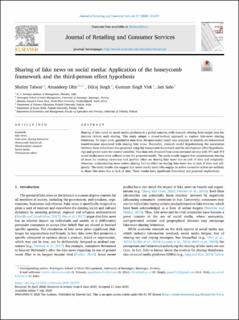| dc.contributor.author | Talwar, Shalini | |
| dc.contributor.author | Dhir, Amandeep | |
| dc.contributor.author | Singh, Dilraj | |
| dc.contributor.author | Virk, Gurnam Singh | |
| dc.contributor.author | Salo, Jari | |
| dc.date.accessioned | 2021-02-22T14:34:01Z | |
| dc.date.available | 2021-02-22T14:34:01Z | |
| dc.date.created | 2020-11-19T11:53:03Z | |
| dc.date.issued | 2020-11 | |
| dc.identifier.citation | Talwar, S., Dhir, A., Singh, D. et al. (2020) Sharing of fake news on social media: Application of the honeycomb framework and the third-person effect hypothesis .Journal of Retailing and Consumer Services, 57, 102197. | en_US |
| dc.identifier.issn | 0969-6989 | |
| dc.identifier.uri | https://hdl.handle.net/11250/2729579 | |
| dc.description.abstract | Sharing of fake news on social media platforms is a global concern, with research offering little insight into the motives behind such sharing. This study adopts a mixed-method approach to explore fake-news sharing behaviour. To begin with, qualitative data from 58 open-ended essays was analysed to identify six behavioural manifestations associated with sharing fake news. Thereafter, research model hypothesizing the association between these behaviours was proposed using the honeycomb framework and the third-person effect hypothesis. Age and gender were the control variables. Two data sets obtained from cross-sectional surveys with 471 and 374 social media users were utilized to test the proposed model. The study results suggest that instantaneous sharing of news for creating awareness had positive effect on sharing fake news due to lack of time and religiosity. However, authenticating news before sharing had no effect on sharing fake news due to lack of time and religiosity. The study results also suggest that social media users who engage in active corrective action are unlikely to share fake news due to lack of time. These results have significant theoretical and practical implications. | en_US |
| dc.language.iso | eng | en_US |
| dc.publisher | Elsevier Ltd. | en_US |
| dc.rights | Navngivelse 4.0 Internasjonal | * |
| dc.rights.uri | http://creativecommons.org/licenses/by/4.0/deed.no | * |
| dc.subject | sosiale medier | en_US |
| dc.subject | fake news | en_US |
| dc.title | Sharing of fake news on social media: Application of the honeycomb framework and the third-person effect hypothesis | en_US |
| dc.type | Peer reviewed | en_US |
| dc.type | Journal article | en_US |
| dc.description.version | publishedVersion | en_US |
| dc.rights.holder | © 2020 The Authors. | en_US |
| dc.subject.nsi | VDP::Samfunnsvitenskap: 200 | en_US |
| dc.source.pagenumber | 11 | en_US |
| dc.source.volume | 57 | en_US |
| dc.source.journal | Journal of Retailing and Consumer Services | en_US |
| dc.identifier.doi | 10.1016/j.jretconser.2020.102197 | |
| dc.identifier.cristin | 1849780 | |
| dc.source.articlenumber | 102197 | en_US |
| cristin.ispublished | true | |
| cristin.fulltext | original | |
| cristin.qualitycode | 1 | |

